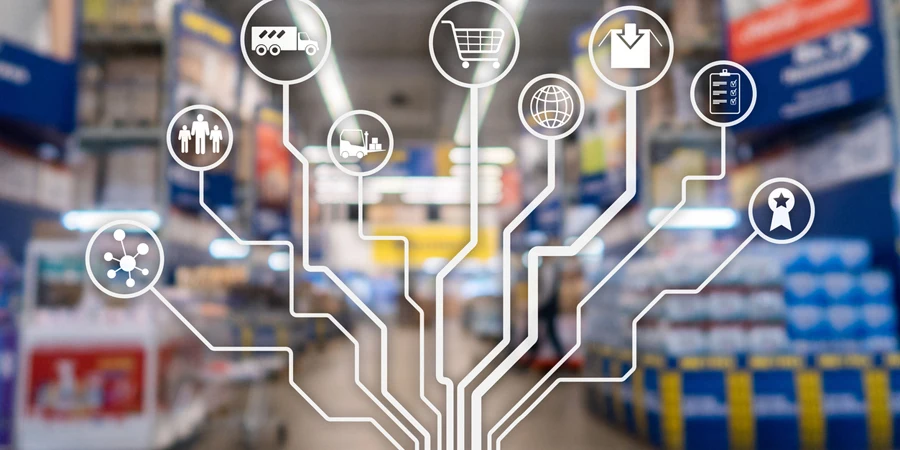AI’s impact is going to touch every corner of the retail media landscape, transforming creative efficiency, personalisation, and marketing data.

The advancements we’ve seen in artificial intelligence (AI) in the last 18 months alone have already made the technology integral to the short-, medium-, and longer-term growth of retail media.
Looking into a crystal ball, we can hazard a guess that consumers’ shopping experience will be very different soon as a result. There’s potential that, as a shopper, before you’ve even thought about the products you need, they’ll be in your basket ready to go. This gives but a taste of the level of intuition that the technology will offer.
Where and why AI is having such a major impact
There are four areas where AI is really driving growth, innovation, and efficiency when it comes to retail media.
Creative efficiency – There’s been a real transition to how retailers and brands can use AI to enhance creative resources, with the aim of being more efficient about where time is being invested when pulling ads together. For example, tools such as Midjourney have already begun to play a critical role in the creative process.
Optimising for personalisation and relevance – In most cases, retailers are now looking at adding customised tag lines, copy, pricing, and layouts, depending on whom they’re trying to reach. These executions can now all be done more efficiently and effectively with the speed and insights AI enables.
The technology’s speed simply cannot be matched by humans. Especially when it comes to retail media, it allows brands to go that step further with their audience planning and not only use their first-party data, but also create predictive audiences who have a greater propensity to buy their products.
Walmart is a great example. A few months ago, they announced their new generative AI functionality. Normally in a search function, you would go in and type individual words like eggs, bread, dog food, etc. Walmart has now introduced the option to be able to type in something like, “cowboy-themed birthday party,” and everything you need for that exact event will come up on that search. It’s really interesting that it’s using AI to be able to pull together and create a full, contextually aligned search page for different customers, depending on their broader needs. Previously, you would have to break this all down.
Data – Yes, we already know that AI is transforming data in terms of the way it’s being used at the backend. But today, brands are now using AI to determine how they can most efficiently target specific audiences they want to reach and how campaigns are measured. AI is only as good as the data that is fed into it, so retail media’s first party data really moves the needle.
In most cases, reporting and optimisation have historically been too fairly manual tasks. AI both evaluates outcomes and forecasts campaign performance based on your success measures, whilst also making its own optimisation decisions to drive the best outcomes.
Operational efficiency – Retailers are using AI at the frontend of their websites to ensure they’re targeting customers with relevant products and search optimisation, as well as at the backend in terms of the supply chain and ecommerce.
In the shorter term, it will be predictive and generative AI that really changes our shopping behaviour. Whereas in the longer term, in-store AI is the next wave of AI we’re going to see. The technology might even be able to see who you are and what you might have bought previously based on your loyalty card and even track records of purchases with certain retailers.
Though AI’s potential is arguably still bubbling under, and we’re currently in somewhat of a trial-and-error period, the technology is undoubtedly going to help propel the industry to the next level.
Within the next three years, it’s highly likely to become a huge catalyst for retail media’s growth. Frankly, I think we’re likely underestimating the impact that this technology will have within the next 3-5 years.
What this means for agencies, brands, and retailers
Consequently, agencies, brands, and retailers need to seriously consider how AI fits into their strategy going forward. They need to be carefully contemplating how it sits within their roadmap, their overall approach to innovation, and what it can offer them. That’s what the bigger brands are doing – i.e. driving efficiencies through AI and using AI to support precision targeting. The rest of the industry needs to be mindful of that.
While the technology hasn’t drastically changed the role of practitioners just yet, they will need to really get to grips with how AI can propel them into a new space, or, indeed, help them get to where they want to reach faster. But they must do all this without straying too far from the human touch, which is essential for solid customer experience and proper creative. This human layer will always be needed in case AI was ever to go rogue.
When it comes to retail media, it is exciting to think of where AI can propel retail media given they go hand in hand. It can drive incredible scale, fuel instant decision making with data and drive a huge number of efficiencies.
We haven’t even begun to see the impacts that it can have on retailer search yet, and paid search accounts for a huge proportion of total retail media spend.
The technology’s impact is going to touch every corner of the industry, and right now, we’ve barely scratched the surface.
About the author: Katrina Smart is VP Digital Commerce, Europe at independently owned global commerce marketing practice, Mars United Commerce.
Source from Retail Insight Network
Disclaimer: The information set forth above is provided by retail-insight-network.com independently of Alibaba.com. Alibaba.com makes no representation and warranties as to the quality and reliability of the seller and products.




